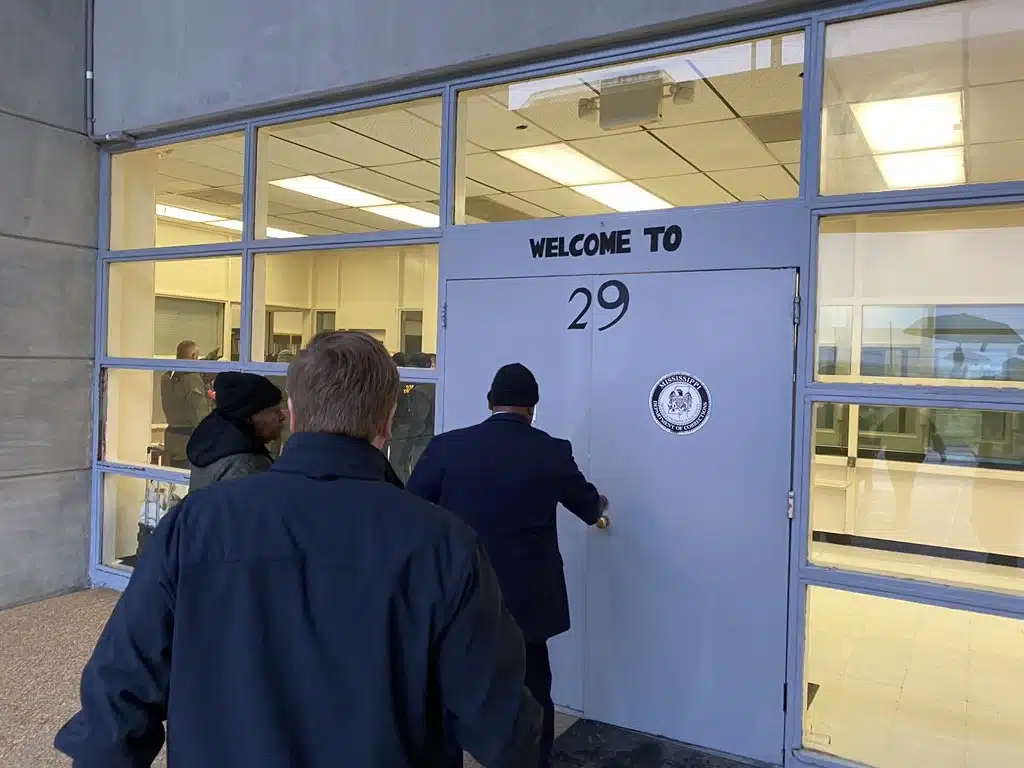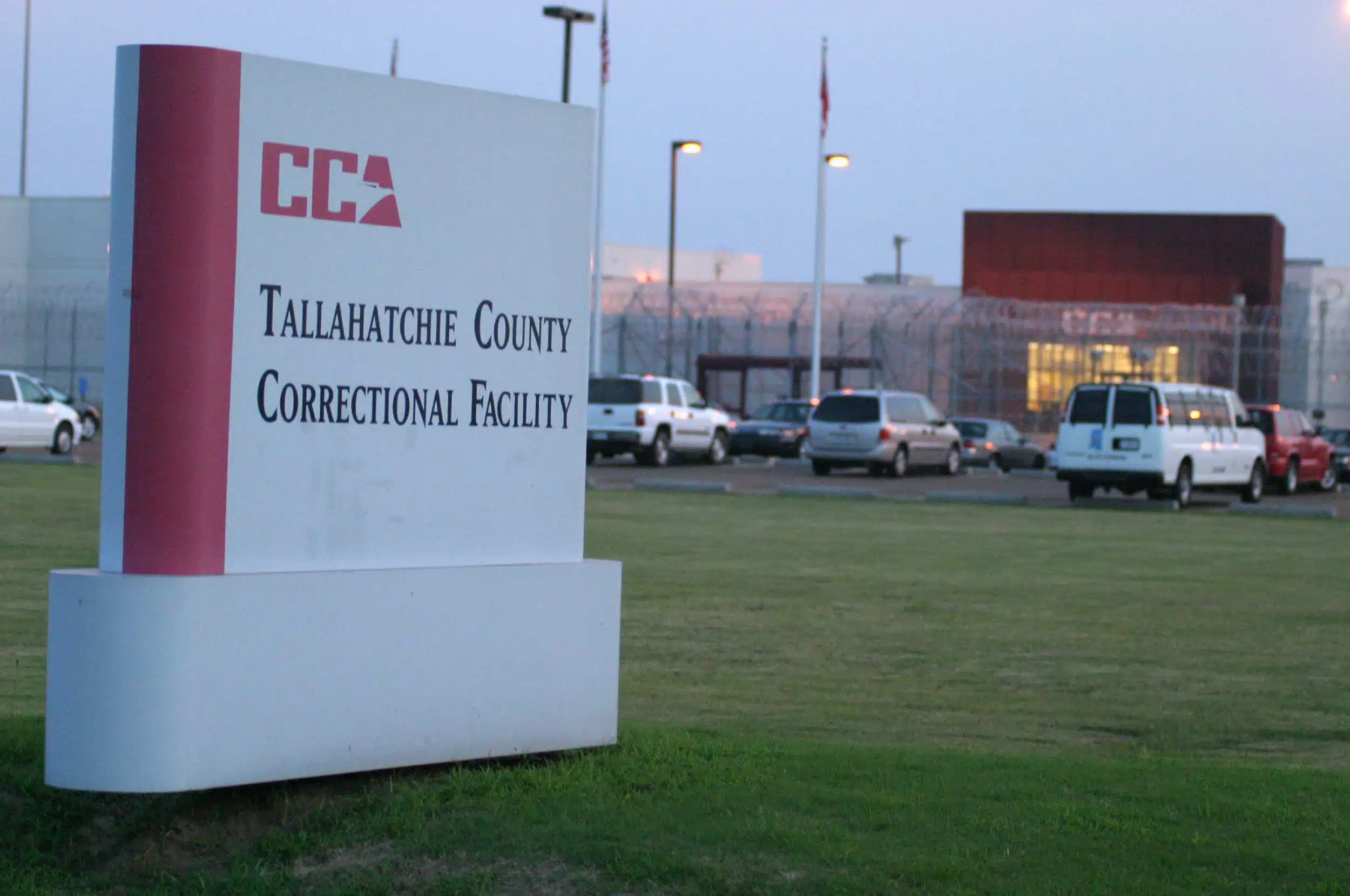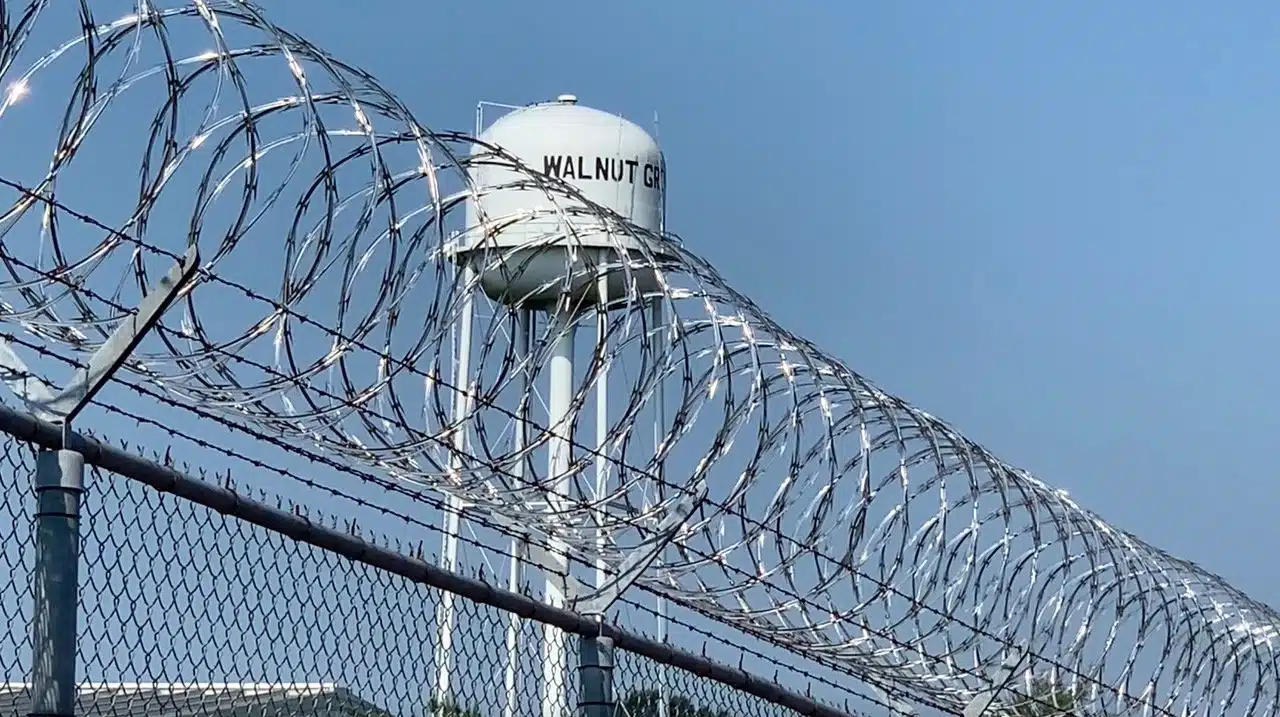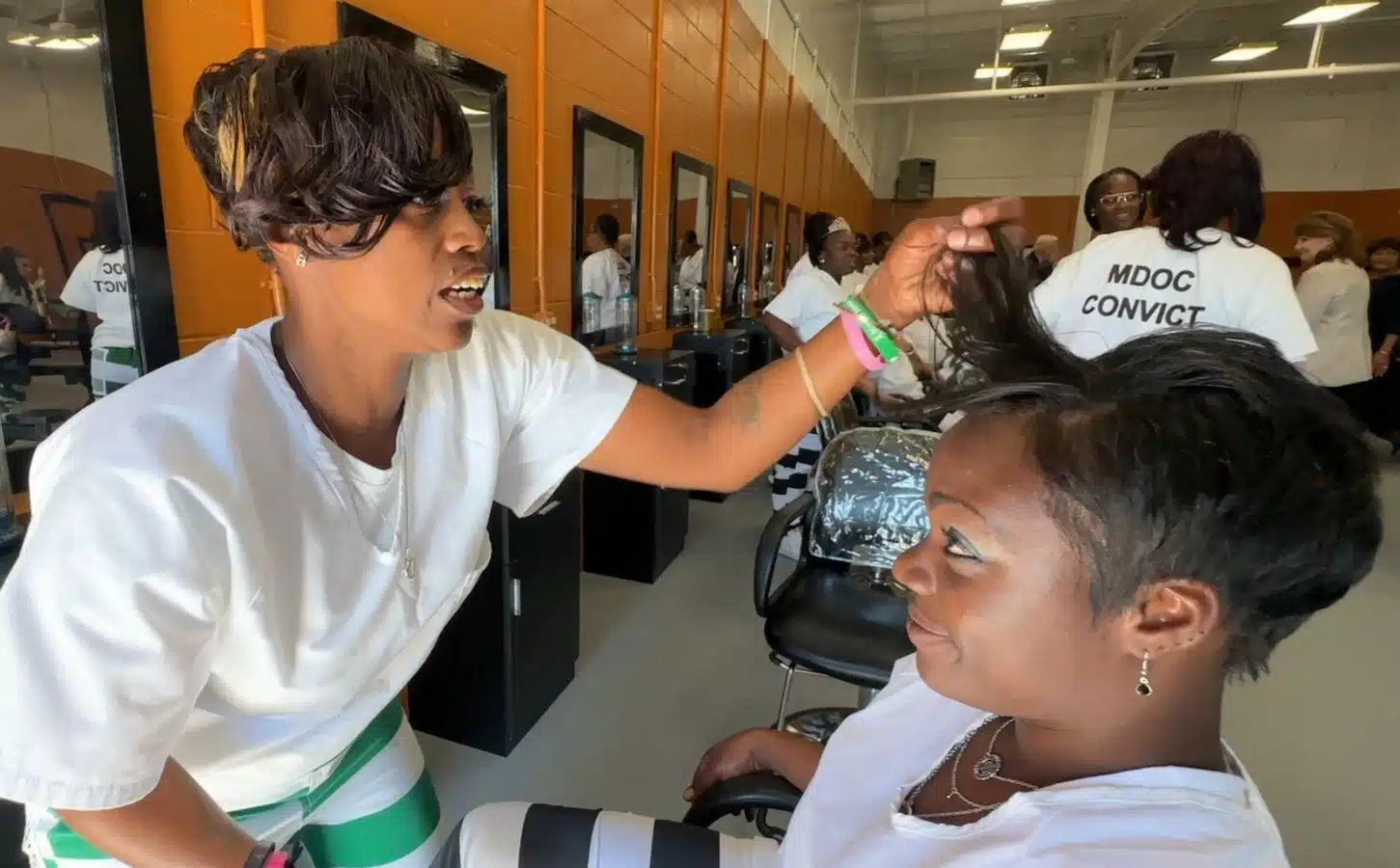Mississippi Today
How Mississippi’s troubled prison system has fared under Tate Reeves and Burl Cain

When Gov. Tate Reeves was sworn into office nearly four years ago, his very first priority was addressing the long-troubled Mississippi prison system.
Deadly riots at the Mississippi State Penitentiary and violence in other state facilities and how state leaders were struggling to address the situation became a major national story. And the Department of Justice had moved in with an investigation into the deplorable conditions and gang violence at four of the prisons.
Reeves, who as governor oversees the Mississippi Department of Corrections, focused on the crisis during his first State of the State address a couple weeks after he was inaugurated.
He vowed in that speech to shut down the worst of the worst, Parchman’s Unit 29, to stem the violence and chaos.
He didn’t.
Today, two-thirds of Unit 29 remains open. The man Reeves put in charge, Burl Cain, said there was no need to shutter the unit and that he could bring it back online through renovations and save the state money.
“I have absolute full confidence in Burl Cain’s ability to change the culture at the Department of Corrections,” Reeves said in May 2020 when he announced Cain’s appointment to oversee the prison system.
“I have absolute confidence he will do so in a manner to make Mississippians proud. I have zero reservations about appointing him,” Reeves said.
The 2020 riots might be over, but the deaths have continued.
Over 300 people have died in Missisisppi’s prisons since Cain became commissioner, with at least 50 of those deaths attributed to homicide, suicide and drug overdoses, according to records between June 2020 and September 2023 from the State Medical Examiner’s Office.
So what has Cain done as commissioner of the Mississippi Department of Corrections?
Mississippi Today, over the past two months, took a deep look at how the long-troubled prison system has fared over the past four years under Cain and Reeves. We interviewed people who are incarcerated, former staff, advocates who have been inside the prisons and state elected officials. We scoured through numerous state documents and reports and federal court filings, submitted open records requests and we spoke with prison officials.
What did we find? Mississippi’s prison system has made some gains, but there is more work to be done.
Incarcerated people still live among crumbling infrastructure. Getting people to work in the prisons continues to be an uphill climb. Gangs continue to hold power over inmates and staff. Efforts to prepare people to return to their communities after incarceration may not be enough.
“Time is short,” Cain said in a September interview with Mississippi Today. “You have four years and we had to rock and roll.”
He was referring to the four-year term of the man who hired him – Reeves. Cain’s name will not appear on any November 2023 state election ballot, but the governor – the person with the ability to keep Cain on the job or dismiss him – is up for a vote. And he’s not running unopposed.
Reeves, in a statement released from his office, said he is grateful for what Cain has been able to accomplish in nearly four years and the commissioner’s ability to solve inherited issues.
Democratic gubernatorial candidate Brandon Presley said in a statement that questions and allegations about Cain’s departure from his previous position in Louisiana give him pause and are why he would look for a different candidate to lead MDOC.
Before coming to Mississippi, Cain, a Louisiana native, was known for reducing violence and incorporating faith into the culture of Angola State Prison, also known as “The Bloodiest Prison in America.”
He had left Angola following questions uncovered in a 2017 audit about his use of corrections staff labor at his private home and receiving benefits for relatives. There were also allegations of his conflicts of interest in business and real estate deals. Throughout the confirmation process, Cain denied the allegations and noted he was not charged with any crime.
Prison violence and other ways to die
Walking into Parchman for the first time, Cain said it reminded him of his first day at Angola.
“It didn’t scare me,” he said.
“It wasn’t something I wasn’t used to, but I knew how to fix it, and that was the advantage I had over other people,” Cain said.
He wanted to prove his work could be replicated. Yet the violence has not abated.

There have been at least eight homicide deaths inside prison facilities during Cain’s tenure – four deaths from blunt force trauma, two stabbings, one from a lung clot and one from thermal injuries, according to records from the State Medical Examiner’s Office.
The data does not include the Sept. 7 stabbing of 23-year-old Raymond Coffey at Parchman, which is believed to be gang-related.
“We’re trying to get home to our families and get people home to their families,” Andrico Pegues, who is incarcerated at the Alcorn County Regional Correctional Facility in Corinth and spent time this year in Parchman’s Unit 29, told Missisisppi Today in a phone call.
More often than not, a majority of inmates die in Mississippi prisons of natural causes. Cancer is the top natural cause of death, according to data from the State Medical Examiner, followed by heart attacks, strokes, lung conditions and liver and kidney diseases.
Disability Rights Mississippi, which has the ability to go inside and investigate the state’s prisons and jails, said it often sees people denied medical and mental health care and accessibility services.
“We’re not seeing really significant improvements on things that incarcerated individuals need,” said Greta Kemp Martin, Disability Rights Mississippi’s litigation director. She is also the Democratic candidate for attorney general.
Disability Rights filed a federal lawsuit in 2021 against MDOC’s medical provider VitalCore Health Strategies and Cain alleging they don’t provide adequate medical and mental health care. The lawsuit is ongoing, and in court records, MDOC and VitalCore have denied the allegations.
MDOC’s COVID-19 response: ‘We made the right decision’
The COVID-19 pandemic has also claimed lives inside Mississippi’s prisons.
At the onset of the pandemic in March 2020, MDOC suspended transfers from all county jails and visitation at all facilities, with exceptions only for attorneys and essential visitors.
By next month, the prison system reported a COVID-19 death: a Parchman inmate with underlying health conditions who had symptoms. The department responded by isolating affected areas, giving close contacts face masks, increasing screening and sanitizing frequently touched areas.
Some family members said officials weren’t doing enough to keep incarcerated people safe.
In May 2020, the Mississippi Center for Justice, MacArthur Justice Center and ACLU of Mississippi filed a class action suit against MDOC for inadequate response to COVID-19 at the Central Mississippi Correctional Facility in Pearl and South Mississippi Correctional Institution in Leakesville. They reached an agreement with MDOC on the grounds the department would implement safety protocols.
By January 2021, MDOC had about 1,380 COVID-19 positive inmates across the system, which Cain noted was better than how other prison systems were faring. He pointed to reporting by The Marshall Project that ranked Mississippi as the 10th safest prison system for only having 21 COVID-19 deaths and 21st for COVID-19 deaths nationwide.
“This is proof that we made the right decision in immediately buying, installing and using sanitization equipment in every area of our prisons as quickly as we could,” Cain said in a 2021 statement. “The temptation had been to wait on thousands of kits to test 17,000 inmates but testing and results would have taken weeks during which the virus could have spread like wildfire.”
SMCI had nearly 400 total COVID-19 cases between early 2020 and June 2022, according to reports released by MDOC online during the pandemic. Next was George/Greene County Correctional Facility with 235 cases, CMCF with 156 cases, Carroll/Montgomery County Regional Correctional Facility with 123 cases and Parchman with 113 total cases.
MDOC’s last online update of confirmed COVID-19 cases is dated June 9, 2022.
Janice Curtis, vice president of Mississippi Dreams Prisoner Advocacy, credited the wardens for taking people to the medical unit or into quarantine if they were exposed to the virus. She also credited Cain for being transparent about the number of active and cumulative cases on MDOC’s website and an effort was made to update the numbers.
The COVID Behind Bars Data Project at UCLA Law School, which tracked cases in state and federal jails, prisons, immigration detention centers and youth facilities, gave Mississippi an F based on how accessible its COVID-19 data was. The project noted that MDOC’s data didn’t include deaths from the virus or count how many staff were infected or died.

The department’s data may not have been the most accurate. Around August 2020 at the private Tallahatchie County Correctional Facility run by CoreCivic, MDOC reported 14 cases even though nearly 150 of the more than 200 Vermont inmates housed there tested positive for the virus when they returned from Mississippi, prompting Vermont prison officials to seek testing for the rest of the state’s inmates in Mississippi.
MDOC began vaccinating people at CMCF in March 2021, one of the first states to do so. Officials said prisoners could decline the vaccine, but documents obtained by Mississippi Today showed refusal could result in loss of privileges, such as visitation and participation in activities.
By September 2021, 89% of the prison population was fully vaccinated.
With inadequate training, ‘you’re going to have chaos’
Perhaps the biggest, and most ongoing challenge, facing Cain at MDOC has been inadequate staffing.
A 2021 report by the Justice Department found that staffing and a lack of supervision threaten the safety of Parchman inmates and staff.
The prison has been operating at half staff since at least 2018, according to the DOJ report. In February 2020, the prison’s overall staffing vacancy was 47% and 52.9% specifically for correctional officers.
Understaffing exists across the prison system. About two-thirds of the authorized security positions are filled at CMCF and about 70% at SMCI, according to MDOC’s 2021 annual report, the most recent available.
How well-trained staff is adds to the already untenable situation.
“If you don’t train the correctional officers to do and know the job, you’re going to have chaos. You will not have control over the situation,” said Anthony Allen, a former correctional officer at Stone County Correctional Facility, which houses state and county inmates.
He said a lack of adequate training hinders staff and inmate safety, and it makes some open to inmate manipulation and later involvement in bringing in contraband.
Cain needed to get more people to work in the prison system, so he made changes, such as lowering the hiring age for correctional officers and raising salaries to attract and retain staff.
Last year, MDOC announced 10% salary increases for current correctional officers and case managers and increases in base pay for new employees. This brought the starting salary for corporal officers to $36,000, $40,000 for sergeants, $42,000 for captains and over $47,000 for majors. There were also benefits packages.
Even with raises, Mississippi remains among the states with the lowest annual mean wage for correctional officers and jailers, according to data from the U.S. Bureau of Labor Statistics.
CMCF now has the largest population of inmates compared to Parchman. MDOC is focusing its staffing efforts in the Jackson metro area because it’s not as easy to attract people to work in the Delta.
Cain said inmates who abuse staff are sent to the Walnut Grove Correctional Facility in Leake County, which he says has helped lower staff violence and help staff feel safe at work.
‘We got to keep drugs out of the prisons’
The presence of gangs and contraband are a threat to Parchman’s safety, the DOJ said in its report.
In a six-month period, 630 cellphones, 555 shanks, pints of alcohol, pounds of tobacco, marijuana and various other drugs were confiscated from inside Parchman, which in its report, the DOJ said points to staff involvement.
Cain said contraband such as drugs and cellphones cause violence, but incarcerated people have used phones to inform the outside world about problems going on inside, such as during the 2020 riots.
To combat phones, Cain wants Congress to pass a law to allow Missisisppi to jam cellphone signals in the prison like the federal prisons are able to do.
Cain has said gang members extort other inmates and their family members. They have used their power to get contraband into the prison, he said, and the gangs are responsible for much of the violence against other inmates and staff.

MDOC has investigated and fired staff from various MDOC facilities found to be smuggling in drugs and other contraband.
Cain is especially cautious about who works at Walnut Grove because it is where gang members are sent. He said anyone who wants to work there has to take a polygraph test and they are asked if they are affiliated with a gang. As with any prison, they can’t work at Walnut Grove if they previously have brought drugs into a prison facility.
The presence of drugs inside the walls also jeopardizes the drug treatment MDOC makes available to inmates, Cain said.
“Addiction is a big deal,” he said, noting how many in the prison system struggle with it. “For addiction (treatment) to really work, we got to try to do everything in our power to keep drugs out of the prisons.”
Amid DOJ probe, lawsuits, state pumps money into MDOC
State leaders, lawmakers and the community were looking to Cain to quell the violence and transform prison culture.
One way to support that task was by increasing the department’s budget. Between 2014 and 2020, MDOC’s budget was cut by $215 million, the Mississippi Center for Investigative Reporting reported.
Rep. Kevin Horan, chairman of the House’s Corrections Committee, said when Cain arrived, he may not have realized how underfunded MDOC was. Leadership and the Governor’s Office realized, with the DOJ investigating its prisons, the department’s budget should be increased to address issues and prevent future lawsuits.
MDOC’s Fiscal Year 2021 budget appropriation was nearly $311 million and appropriations have risen each year to the most recent appropriation of about $450 million, according to the Legislative Budget Office. The department received additional money from special fund appropriations and other sources.
With an increased budget, MDOC has been able to spend more on its prison facilities each year since Cain has been commissioner, according to the department budgets since Fiscal Year 2021.
Cain said MDOC used $19 million to restore Parchman, notably cleaning up and fixing cells inside Unit 29, and the roof is being fixed. He said a new death row is expected to open in a year and a half.
The most recent Mississippi State Health Department inspection of Parchman completed in September 2022 documented backed- up shower drains, running or leaking toilets, lights out, mold and pests in various housing cells. Similar issues were found in other housing units and inspections from 2020 and 2021.

Former MDOC staff and incarcerated people interviewed by Mississippi Today say these conditions are a violation of peoples’ constitutional rights.
Larry Waldon, incarcerated at the Holmes/Humphreys County Correctional Facility in Lexington, has advocated for reform while in prison, including through Mississippi Prison Reform Advocates.
Several weeks ago, he and a dozen other incarcerated people spoke with Mississippi Today on a group call where they shared a fraction of their experiences in the prison system and what kind of change they would like to see.
They talked about brown drinking water. One remembered not being able to sleep in the summer because of the mosquitoes. They witnessed violence among inmates and by staff.
Waldon wonders how incarcerated people at various MDOC facilities live in the conditions they do despite the millions the department receives from taxpayers.
“Inmates can’t tell the difference that you (the commissioner) have done things that are positive,” he said.
These are similar to the health and safety conditions that in 2020 caught the attention of rappers Jay-Z and Yo Gotti, who through Roc Nation filed two federal lawsuits on behalf of Mississippi prisoners and demanded state officials to fix Parchman or close the prison.
The lawsuits were dismissed in January after the inmates’ attorneys and MDOC said improvements have been made during the past three years, but the entertainers promised to continue to hold MDOC accountable and work toward long-lasting change that protects inmate safety.
Isolate problem inmates
Under Cain, two prison buildings have been refurbished and reopened to house maximum security inmates, those undergoing drug and alcohol treatment and women inmates.
A federal lawsuit closed the privately run Walnut Grove Correctional Facility in 2016, which a federal judge described as a “picture of such horror as should be unrealized anywhere in the civilized world.” It housed people convicted for serious crimes when they were children.

Cain saw a new use for the facility: alcohol and substance addiction programs on one side and on the other, a maximum-security facility for gang members, those who attack corrections staff and those who extort others.
In an interview, Cain said the facility is modeled after Angola’s disciplinary unit, the now-closed Camp J, and he said it is having a similar effect to help ease violence. Cain said the goal of isolating problem inmates is to protect the majority who are trying to stay out of trouble and better themselves.
“If you can’t peacefully co-exist, go live by yourself,” he said about sending people to Walnut Grove.
Cain said Walnut Grove has also helped reduce the prison-wide gang population from 6,400 when he took office to 1,400 more recently.
However, some former prison staff members and current inmates interviewed by Mississippi Today don’t see Walnut Grove as a complete solution. The DOJ said in its 2021 report that the strategy of sending gang leaders away isn’t a comprehensive strategy because a new leader will emerge to replace them.
The next facility to reopen was Delta Correctional Facility, a women’s facility in Greenwood that was a private prison and closed in 2012.
By the end of 2022, most of the women were moved to Delta Correctional. The move put women further away from their families and into an area lacking adequate health care options, particularly for gynecological care.
Women had been exclusively housed at CMCF since the early 2000s separate from the men, but last year had to leave their longtime space in the 1A Yard to go to 720, a men’s unit – a decision the women protested. Cain said the move was meant to limit interaction between the men and women.
As of October, there are about 330 women at Delta and about 850 at CMCF, according to MDOC records. In an interview, Cain said the two women’s facilities satisfy a need for additional space.
“That’s why it was just time (to open Delta) to anticipate in the next 15 years or so we’d have more women, so might as well divide it and conquer it right now,” he said.
Cain’s four pillars for fixing prisons
In his 2020 confirmation hearing, Cain described four main tenets to fixing the prison system: good food, good medicine, good playing and good praying.
He went on to say that he wanted to build churches in the state’s prisons and start ministry programs like at Angola. That promise was realized this summer when a chapel at the women’s unit at CMCF opened for services.
Cain said there are plans to place churches at SMCI and Parchman through private donations, which is how the first church was built.
In Mississippi’s prisons, inmates can earn a seminary degree from New Orleans Baptist Theological Seminary and become chaplains. Senior U.S. District Judge Keith Starrett, who has long advocated for prison reform, said, through spiritual programs, work and character components, Cain is helping people build new habits and lifestyles with accountability.
Another path inmates may take to improve themselves is education.
The state prisons and regional facilities have high school diploma programs. Some offer college level courses through the Prison-to-College Pipeline Program by the University of Mississippi, and Mississippi Valley State University is the first HBCU to offer a prison education program.
Kerry Gipson, who is incarcerated at the Holmes/Humphreys County Correctional Facility, wants to see more classes and educational programs. The commissioner talks about bringing programs across the prison system, “but (they are) not everywhere like he promised,” Gipson said.
Lead by example
In his nearly four years as commissioner, Cain has focused on skilled job training programs that he said he believes will give people careers after prison.
He plans to ask the Legislature to expand a work release program, following success from the pilot last year that operated through the Rankin County Sheriff’s Office. He said none of the participants returned to prison and they were able to go home with $2,000 in their pockets.
Cain said he wants to lead by example and encourage business owners to hire formerly incarcerated people, which is what he did for chaplains and other MDOC staff. Among them is George King, who served 25 years at Angola for manslaughter and now is the MDOC’s statewide program director.
Through MDOC’s job training schools, inmates can learn to drive and pour concrete trucks. They can train to be a commercial truck driver through a simulator. They learn to weld in a mobile unit that travels among the prisons. Cain wants people to walk out with certifications and licenses.
While women can also participate in those programs, there are also some specifically for them, such as the cosmetology school that opened last month at Delta Correctional.

In the spring, nearly 30 women close to release at the Flowood Community Work Center graduated from a health services program – MDOC’s first reentry program at the center.
The commissioner doesn’t think the men have better job opportunities available to them than the women. Women can join the programs from traditionally male-dominated, better-paying industries, he said. They just need the motivation to go into those fields and learn different skills.
Curtis, of Mississippi Dreams Prisoner Advocacy, said that barrier still exists, and often it seems that the women don’t get as many options to better themselves.
Can one person fix Mississippi’s prisons?
Cain sees job training, education and morality as the pillars of reentry – the way to reduce recidivism and the taxpayer’s burden to fund the prison system.
Judge Starrett said he has learned that you can’t send someone to prison for a few years and expect them to change their lives. Seeing Cain focus on skills training and reentry reinforces his view that the commissioner is doing the right thing.
It took a year to get the training schools running, and the commissioner hopes the Legislature will support his request for more programs. The process has been slow, and Cain said he’s in a hurry to do more – prevent people from returning and from there being new crime victims.
“We’re taking in several thousand people this last year and several thousand people left. They left unprepared. We’re failing” he said. “We got to have them prepared so they don’t fail, so I’m in a hurry for their sake.”
Incarcerated people and advocates, however, don’t see the state’s reentry efforts as enough.
Tomon Clark, who is incarcerated at the Washington County Regional Correctional Facility in Greenville, said he and others don’t have the same access to job training programs like there are at the prisons.
He also wants to see more at his regional facility to prevent people from sitting around and learning to become better criminals.
“You can’t rehabilitate them if there’s not opportunity,” he said by phone.
Kemp Martin has had clients through Disability Rights Mississippi who want to work or attend school, but she said they are discouraged from participating because they have mobility challenges, and they would need to get a prison staff member to take them to the programs.
“I don’t care how much training you give someone or how set up for a job they are afterward,” she said. “If while they are incarcerated they languish, they are not treated for medical issues they have and they are not given mental health treatment, they are not fully set up for success.”
Meanwhile, Mississippi leads the world in mass incarceration. Since May 2022, the prison population has been above 19,000 – an increase from the population low of around 17,000 MDOC reached during the COVID-19 pandemic.
Advocates are looking for solutions to ease the prison population, such as sentencing reform, supporting a functioning indigent public defense system and parole.
Can Mississippi’s prisons be fixed by one person? Not everyone thinks so.
“There are so many systemic things wrong with MDOC,” said Paloma Wu, from the Mississippi Center for Justice. “I don’t think any one commissioner can come in and have a huge dent.”
This article first appeared on Mississippi Today and is republished here under a Creative Commons license.
Mississippi Today
Mississippi prepares for another execution
The Mississippi Supreme Court has set the execution of a man who kidnapped and murdered a 20-year-old community college student in north Mississippi 30 years ago.
Charles Ray Crawford, 59, is set to be executed Oct. 15 at the Mississippi State Penitentiary at Parchman, after multiple requests by the attorney general’s office.
Eight justices joined the majority opinion to set the execution, concluding that Crawford has exhausted all state and federal legal remedies. Mississippi Supreme Court Justice T. Kenneth Griffis Jr. wrote the Friday opinion. Justice David Sullivan did not participate.
However, Kristy Noble with the Mississippi Office of Capital Post-Conviction Counsel released a statement saying it will file another appeal with the U.S. Supreme Court.
“”Mr. Crawford’s inexperienced trial counsel conceded his guilt to the jury — against Mr.
Crawford’s timely and repeated objections,” Noble said in the statement. “Mr. Crawford told his counsel to pursue a not guilty verdict. Counsel did just the opposite, which is precisely what the U.S. Supreme Court says counsel cannot do,” Noble said in the statement.
“A trial like Mr. Crawford’s – one where counsel concedes guilt over his client’s express wishes – is essentially no trial at all.”
Last fall, Crawford’s attorneys asked the court not to set an execution date because he hadn’t exhausted appeal efforts in federal court to challenge a rape conviction that is not tied to his death sentence. In June, the U.S. Supreme Court declined to take up Crawford’s case.
A similar delay occurred a decade ago, when the AG’s office asked the court to reset Crawford’s execution date, but that was denied because efforts to appeal his unrelated rape conviction were still pending.
After each unsuccessful filing, the attorney general’s office asked the Mississippi Supreme Court to set Crawford’s execution date.
On Friday, the court also denied Crawford’s third petition for post-conviction relief and a request for oral argument. It accepted the state’s motion to dismiss the petition. Seven justices concurred and Justice Leslie King concurred in result only. Again, Justice Sullivan did not participate.
Crawford was convicted and sentenced to death in Lafayette County for the 1993 rape and murder of North Mississippi Community College student Kristy Ray.
Days before he was set to go to trial on separate aggravated assault and rape charges, he kidnapped Ray from her parents’ Tippah County home, leaving ransom notes. Crawford took Ray to an abandoned barn where he stabbed her, and his DNA was found on her, indicating he sexually assaulted her, according to court records.
Crawford told police he had blackouts and only remembered parts of the crime, but not killing Ray. Later he admitted “he must of killed her” and led police to Ray’s body, according to court records.
At his 1994 trial he presented an insanity defense, including that he suffered from psychogenic amnesia – periods of time lapse without memory. Medical experts who provided rebuttal testimony said Crawford didn’t have psychogenic amnesia and didn’t show evidence of bipolar illness.
The last person executed in Mississippi was Richard Jordan in June, previously the state’s oldest and longest serving person on death row.
There are 36 people on death row, according to records from the Mississippi Department of Corrections.
Update 9/15/25: This story has been updated to include a response from the Mississippi Office of Capital Post-Conviction Counsel
This article first appeared on Mississippi Today and is republished here under a Creative Commons Attribution-NoDerivatives 4.0 International License.
The post Mississippi prepares for another execution appeared first on mississippitoday.org
Note: The following A.I. based commentary is not part of the original article, reproduced above, but is offered in the hopes that it will promote greater media literacy and critical thinking, by making any potential bias more visible to the reader –Staff Editor.
Political Bias Rating: Centrist
The article presents a factual and balanced account of the legal proceedings surrounding a scheduled execution in Mississippi. It includes perspectives from both the state’s attorney general’s office and the defense counsel, without using emotionally charged language or advocating for a particular political stance. The focus on legal details and court decisions reflects a neutral, informative approach typical of centrist reporting.
Mississippi Today
Presidents are taking longer to declare major natural disasters. For some, the wait is agonizing
TYLERTOWN — As an ominous storm approached Buddy Anthony’s one-story brick home, he took shelter in his new Ford F-250 pickup parked under a nearby carport.
Seconds later, a tornado tore apart Anthony’s home and damaged the truck while lifting it partly in the air. Anthony emerged unhurt. But he had to replace his vehicle with a used truck that became his home while waiting for President Donald Trump to issue a major disaster declaration so that federal money would be freed for individuals reeling from loss. That took weeks.
“You wake up in the truck and look out the windshield and see nothing. That’s hard. That’s hard to swallow,” Anthony said.
Disaster survivors are having to wait longer to get aid from the federal government, according to a new Associated Press analysis of decades of data. On average, it took less than two weeks for a governor’s request for a presidential disaster declaration to be granted in the 1990s and early 2000s. That rose to about three weeks during the past decade under presidents from both major parties. It’s taking more than a month, on average, during Trump’s current term, the AP found.
The delays mean individuals must wait to receive federal aid for daily living expenses, temporary lodging and home repairs. Delays in disaster declarations also can hamper recovery efforts by local officials uncertain whether they will receive federal reimbursement for cleaning up debris and rebuilding infrastructure. The AP collaborated with Mississippi Today and Mississippi Free Press on the effects of these delays for this report.
“The message that I get in the delay, particularly for the individual assistance, is that the federal government has turned its back on its own people,” said Bob Griffin, dean of the College of Emergency Preparedness, Homeland Security and Cybersecurity at the University at Albany in New York. “It’s a fundamental shift in the position of this country.”
The wait for disaster aid has grown as Trump remakes government
The Federal Emergency Management Agency often consults immediately with communities to coordinate their initial disaster response. But direct payments to individuals, nonprofits and local governments must wait for a major disaster declaration from the president, who first must receive a request from a state, territory or tribe. Major disaster declarations are intended only for the most damaging events that are beyond the resources of states and local governments.
Trump has approved more than two dozen major disaster declarations since taking office in January, with an average wait of almost 34 days after a request. That ranged from a one-day turnaround after July’s deadly flash flooding in Texas to a 67-day wait after a request for aid because of a Michigan ice storm. The average wait is up from a 24-day delay during his first term and is nearly four times as long as the average for former Republican President George H.W. Bush, whose term from 1989-1993 coincided with the implementation of a new federal law setting parameters for disaster determinations.
The delays have grown over time, regardless of the party in power. Former Democratic President Joe Biden, in his last year in office, averaged 26 days to declare major disasters — longer than any year under former Democratic President Barack Obama.

FEMA did not respond to the AP’s questions about what factors are contributing to the trend.
Others familiar with FEMA noted that its process for assessing and documenting natural disasters has become more complex over time. Disasters have also become more frequent and intense because of climate change, which is mostly caused by the burning of fuels such as gas, coal and oil.
The wait for disaster declarations has spiked as Trump’s administration undertakes an ambitious makeover of the federal government that has shed thousands of workers and reexamined the role of FEMA. A recently published letter from current and former FEMA employees warned the cuts could become debilitating if faced with a large-enough disaster. The letter also lamented that the Trump administration has stopped maintaining or removed long-term planning tools focused on extreme weather and disasters.
Shortly after taking office, Trump floated the idea of “getting rid” of FEMA, asserting: “It’s very bureaucratic, and it’s very slow.”
FEMA’s acting chief suggested more recently that states should shoulder more responsibility for disaster recovery, though FEMA thus far has continued to cover three-fourths of the costs of public assistance to local governments, as required under federal law. FEMA pays the full cost of its individual assistance.
Former FEMA Administrator Pete Gaynor, who served during Trump’s first term, said the delay in issuing major disaster declarations likely is related to a renewed focus on making sure the federal government isn’t paying for things state and local governments could handle.
“I think they’re probably giving those requests more scrutiny,” Gaynor said. “And I think it’s probably the right thing to do, because I think the (disaster) declaration process has become the ‘easy button’ for states.”
The Associated Press on Monday received a statement from White House spokeswoman Abigail Jackson in response to a question about why it is taking longer to issue major natural disaster declarations:
“President Trump provides a more thorough review of disaster declaration requests than any Administration has before him. Gone are the days of rubber stamping FEMA recommendations – that’s not a bug, that’s a feature. Under prior Administrations, FEMA’s outsized role created a bloated bureaucracy that disincentivized state investment in their own resilience. President Trump is committed to right-sizing the Federal government while empowering state and local governments by enabling them to better understand, plan for, and ultimately address the needs of their citizens. The Trump Administration has expeditiously provided assistance to disasters while ensuring taxpayer dollars are spent wisely to supplement state actions, not replace them.”

In Mississippi, frustration festered during wait for aid
The tornado that struck Anthony’s home in rural Tylertown on March 15 packed winds up to 140 mph. It was part of a powerful system that wrecked homes, businesses and lives across multiple states.
Mississippi’s governor requested a federal disaster declaration on April 1. Trump granted that request 50 days later, on May 21, while approving aid for both individuals and public entities.
On that same day, Trump also approved eight other major disaster declarations for storms, floods or fires in seven other states. In most cases, more than a month had passed since the request and about two months since the date of those disasters.
If a presidential declaration and federal money had come sooner, Anthony said he wouldn’t have needed to spend weeks sleeping in a truck before he could afford to rent the trailer where he is now living. His house was uninsured, Anthony said, and FEMA eventually gave him $30,000.
In nearby Jayess in Lawrence County, Dana Grimes had insurance but not enough to cover the full value of her damaged home. After the eventual federal declaration, Grimes said FEMA provided about $750 for emergency expenses, but she is now waiting for the agency to determine whether she can receive more.

“We couldn’t figure out why the president took so long to help people in this country,” Grimes said. “I just want to tie up strings and move on. But FEMA — I’m still fooling with FEMA.”
Jonathan Young said he gave up on applying for FEMA aid after the Tylertown tornado killed his 7-year-old son and destroyed their home. The process seemed too difficult, and federal officials wanted paperwork he didn’t have, Young said. He made ends meet by working for those cleaning up from the storm.
“It’s a therapy for me,” Young said, “to pick up the debris that took my son away from me.”
Historically, presidential disaster declarations containing individual assistance have been approved more quickly than those providing assistance only to public entities, according to the AP’s analysis. That remains the case under Trump, though declarations for both types are taking longer.
About half the major disaster declarations approved by Trump this year have included individual assistance.
Some people whose homes are damaged turn to shelters hosted by churches or local nonprofit organizations in the initial chaotic days after a disaster. Others stay with friends or family or go to a hotel, if they can afford it.
But some insist on staying in damaged homes, even if they are unsafe, said Chris Smith, who administered FEMA’s individual assistance division under three presidents from 2015-2022. If homes aren’t repaired properly, mold can grow, compounding the recovery challenges.

That’s why it’s critical for FEMA’s individual assistance to get approved quickly — ideally, within two weeks of a disaster, said Smith, who’s now a disaster consultant for governments and companies.
“You want to keep the people where they are living. You want to ensure those communities are going to continue to be viable and recover,” Smith said. “And the earlier that individual assistance can be delivered … the earlier recovery can start.”
In the periods waiting for declarations, the pressure falls on local officials and volunteers to care for victims and distribute supplies.
In Walthall County, where Tylertown is, insurance agent Les Lampton remembered watching the weather news as the first tornado missed his house by just an eighth of a mile. Lampton, who moonlights as a volunteer firefighter, navigated the collapsed trees in his yard and jumped into action. About 45 minutes later, the second tornado hit just a mile away.
“It was just chaos from there on out,” Lampton said.
Walthall County, with a population of about 14,000, hasn’t had a working tornado siren in about 30 years, Lampton said. He added there isn’t a public safe room in the area, although a lot of residents have ones in their home.
Rural areas with limited resources are hit hard by delays in receiving funds through FEMA’s public assistance program, which, unlike individual assistance, only reimburses local entities after their bills are paid. Long waits can stoke uncertainty and lead cost-conscious local officials to pause or scale-back their recovery efforts.

In Walthall County, officials initially spent about $700,000 cleaning up debris, then suspended the cleanup for more than a month because they couldn’t afford to spend more without assurance they would receive federal reimbursement, said county emergency manager Royce McKee. Meanwhile, rubble from splintered trees and shattered homes remained piled along the roadside, creating unsafe obstacles for motorists and habitat for snakes and rodents.
When it received the federal declaration, Walthall County took out a multimillion-dollar loan to pay contractors to resume the cleanup.
“We’re going to pay interest and pay that money back until FEMA pays us,” said Byran Martin, an elected county supervisor. “We’re hopeful that we’ll get some money by the first of the year, but people are telling us that it could be [longer].”
Lampton, who took after his father when he joined the volunteer firefighters 40 years ago, lauded the support of outside groups such as Cajun Navy, Eight Days of Hope, Samaritan’s Purse and others. That’s not to mention the neighbors who brought their own skid steers and power saws to help clear trees and other debris, he added.
“That’s the only thing that got us through this storm, neighbors helping neighbors,” Lampton said. “If we waited on the government, we were going to be in bad shape.”
Lieb reported from Jefferson City, Missouri, and Wildeman from Hartford, Connecticut.
Update 98/25: This story has been updated to include a White House statement released after publication.
This article first appeared on Mississippi Today and is republished here under a Creative Commons Attribution-NoDerivatives 4.0 International License.
The post Presidents are taking longer to declare major natural disasters. For some, the wait is agonizing appeared first on mississippitoday.org
Note: The following A.I. based commentary is not part of the original article, reproduced above, but is offered in the hopes that it will promote greater media literacy and critical thinking, by making any potential bias more visible to the reader –Staff Editor.
Political Bias Rating: Center-Left
This article presents a critical view of the Trump administration’s handling of disaster declarations, highlighting delays and their negative impacts on affected individuals and communities. It emphasizes concerns about government downsizing and reduced federal support, themes often associated with center-left perspectives that favor robust government intervention and social safety nets. However, it also includes statements from Trump administration officials defending their approach, providing some balance. Overall, the tone and framing lean slightly left of center without being overtly partisan.
Mississippi Today
Northeast Mississippi speaker and worm farmer played key role in Coast recovery after Hurricane Katrina
The 20th anniversary of Hurricane Katrina slamming the Mississippi Gulf Coast has come and gone, rightfully garnering considerable media attention.
But still undercovered in the 20th anniversary saga of the storm that made landfall on Aug. 29, 2005, and caused unprecedented destruction is the role that a worm farmer from northeast Mississippi played in helping to revitalize the Coast.
House Speaker Billy McCoy, who died in 2019, was a worm farmer from the Prentiss, not Alcorn County, side of Rienzi — about as far away from the Gulf Coast as one could be in Mississippi.
McCoy grew other crops, but a staple of his operations was worm farming.
Early after the storm, the House speaker made a point of touring the Coast and visiting as many of the House members who lived on the Coast as he could to check on them.
But it was his action in the forum he loved the most — the Mississippi House — that is credited with being key to the Coast’s recovery.
Gov. Haley Barbour had called a special session about a month after the storm to take up multiple issues related to Katrina and the Gulf Coast’s survival and revitalization. The issue that received the most attention was Barbour’s proposal to remove the requirement that the casinos on the Coast be floating in the Mississippi Sound.
Katrina wreaked havoc on the floating casinos, and many operators said they would not rebuild if their casinos had to be in the Gulf waters. That was a crucial issue since the casinos were a major economic engine on the Coast, employing an estimated 30,000 in direct and indirect jobs.
It is difficult to fathom now the controversy surrounding Barbour’s proposal to allow the casinos to locate on land next to the water. Mississippi’s casino industry that was birthed with the early 1990s legislation was still new and controversial.
Various religious groups and others had continued to fight and oppose the casino industry and had made opposition to the expansion of gambling a priority.
Opposition to casinos and expansion of casinos was believed to be especially strong in rural areas, like those found in McCoy’s beloved northeast Mississippi. It was many of those rural areas that were the homes to rural white Democrats — now all but extinct in the Legislature but at the time still a force in the House.
So, voting in favor of casino expansion had the potential of being costly for what was McCoy’s base of power: the rural white Democrats.
Couple that with the fact that the Democratic-controlled House had been at odds with the Republican Barbour on multiple issues ranging from education funding to health care since Barbour was inaugurated in January 2004.
Barbour set records for the number of special sessions called by the governor. Those special sessions often were called to try to force the Democratic-controlled House to pass legislation it killed during the regular session.
The September 2005 special session was Barbour’s fifth of the year. For context, current Gov. Tate Reeves has called four in his nearly six years as governor.
There was little reason to expect McCoy to do Barbour’s bidding and lead the effort in the Legislature to pass his most controversial proposal: expanding casino gambling.
But when Barbour ally Lt. Gov. Amy Tuck, who presided over the Senate, refused to take up the controversial bill, Barbour was forced to turn to McCoy.
The former governor wrote about the circumstances in an essay he penned on the 20th anniversary of Hurricane Katrina for Mississippi Today Ideas.
“The Senate leadership, all Republicans, did not want to go first in passing the onshore casino law,” Barbour wrote. “So, I had to ask Speaker McCoy to allow it to come to the House floor and pass. He realized he should put the Coast and the state’s interests first. He did so, and the bill passed 61-53, with McCoy voting no.
“I will always admire Speaker McCoy, often my nemesis, for his integrity in putting the state first.”
Incidentally, former Rep. Bill Miles of Fulton, also in northeast Mississippi, was tasked by McCoy with counting, not whipping votes, to see if there was enough support in the House to pass the proposal. Not soon before the key vote, Miles said years later, he went to McCoy and told him there were more than enough votes to pass the legislation so he was voting no and broached the idea of the speaker also voting no.
It is likely that McCoy would have voted for the bill if his vote was needed.
Despite his no vote, the Biloxi Sun Herald newspaper ran a large photo of McCoy and hailed the Rienzi worm farmer as a hero for the Mississippi Gulf Coast.
This article first appeared on Mississippi Today and is republished here under a Creative Commons Attribution-NoDerivatives 4.0 International License.
The post Northeast Mississippi speaker and worm farmer played key role in Coast recovery after Hurricane Katrina appeared first on mississippitoday.org
Note: The following A.I. based commentary is not part of the original article, reproduced above, but is offered in the hopes that it will promote greater media literacy and critical thinking, by making any potential bias more visible to the reader –Staff Editor.
Political Bias Rating: Centrist
The article presents a factual and balanced account of the political dynamics surrounding Hurricane Katrina recovery efforts in Mississippi, focusing on bipartisan cooperation between Democratic and Republican leaders. It highlights the complexities of legislative decisions without overtly favoring one party or ideology, reflecting a neutral and informative tone typical of centrist reporting.
-
News from the South - Kentucky News Feed7 days ago
Lexington man accused of carjacking, firing gun during police chase faces federal firearm charge
-
News from the South - Alabama News Feed7 days ago
Zaxby's Player of the Week: Dylan Jackson, Vigor WR
-
News from the South - Arkansas News Feed7 days ago
Arkansas medical marijuana sales on pace for record year
-
News from the South - North Carolina News Feed5 days ago
What we know about Charlie Kirk shooting suspect, how he was caught
-
News from the South - Missouri News Feed7 days ago
Local, statewide officials react to Charlie Kirk death after shooting in Utah
-
Local News7 days ago
US stocks inch to more records as inflation slows and Oracle soars
-
Local News6 days ago
Russian drone incursion in Poland prompts NATO leaders to take stock of bigger threats
-
Local News Video6 days ago
Introducing our WXXV Student Athlete of the Week, St. Patrick’s Parker Talley!










































